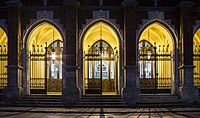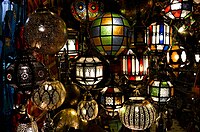This article may be in need of reorganization to comply with Wikipedia's
layout guidelines. (February 2014) |
Intelligent street lighting refers to public street lighting that adapts to movement by pedestrians, cyclists and cars in a smart city. [1] Also called adaptive street lighting, it brightens when sensing activity and dims while not. This is different from traditional stationary illumination, and that which dims on a timer.
History
Europe
The first patent requests for intelligent street lighting stem from the late 1990s. [2] But it was not until April 7, 2006, that Europe experienced the first large scale implementation of a control network in a street lighting application. The implementation took place in Oslo (Norway) and it was expected to reduce energy usage by 50 percent, improve roadway safety, and minimize maintenance costs. [3]
The Oslo project triggered interest from other cities in Europe, and formed the basis for other sustainability initiatives, such as the E-Street initiative. This research group focused on ways to reduce energy usage in outdoor lighting systems in the European Union (EU). The E-Street group strongly influenced EU standards and legislation for intelligent outdoor lighting systems. [4]
Features
Street lights can be made intelligent by placing cameras or other sensors on them, which enables them to detect movement (e.g. Sensity's Light Sensory Network, GE's "Currents", Tvilight's CitySense). [5] [6] Additional technology enables the street lights to communicate with one another. Different companies have different variations to this technology. When a passer-by is detected by a camera or sensor, it will communicate this to neighboring street lights, which will brighten so that people are always surrounded by a safe circle of light. [7] The SmartLighting technology of the Anhalt University of Applied Sciences does this as well, and has been installed in Bernburg-Strenzfeld in Germany. [8] Street lights illuminate at a longer distance ahead of the pedestrian than behind the pedestrian in the SmartLighting concept.
Control
Some companies also offer software with which the street lights can be monitored and managed wirelessly. Clients, or other companies, can access the software from a computer, or even a tablet. From this software, they can gather data, pre-set levels of brightness and dimming time; receive warning signals when a light defects. [9] [10] [11]
Guidelines
The U.S. Federal Highway Administration has issued guidelines to provide a process by which a governmental agency or a lighting designer can select the required lighting level for a road or street and implement adaptive lighting for a lighting installation or lighting retrofit. [12]
References
- ^ Muthanna, M. S. A.; Muthanna, M. M. A.; Khakimov, A.; Muthanna, A. (January 2018). "Development of intelligent street lighting services model based on LoRa technology". 2018 IEEE Conference of Russian Young Researchers in Electrical and Electronic Engineering (EIConRus). pp. 90–93. doi: 10.1109/EIConRus.2018.8317037. ISBN 978-1-5386-4339-6. S2CID 3935434. Retrieved 1 April 2021.
- ^ "Intelligent outdoor lighting control system Patent (Patent # 6,204,615 issued March 20, 2001) - Justia Patents Database". Patents.justia.com. Retrieved 2015-12-24.
- ^ "Oslo to cut streetlight energy costs by 30% while increasing safety". Gizmag.com. 7 April 2006. Retrieved 2015-12-24.
- ^ "Oslo to cut streetlight energy costs by 30% while increasing safety". Gizmag.com. 7 April 2006. Retrieved 2015-12-24.
- ^ https://static1.squarespace.com/static/53d2cdffe4b069e965155fc8/t/5693fc26dc5cb4e20e40b151/1452538926885/20160111_NetSense-Cities.pdf Archived 2016-03-28 at the Wayback Machine [ bare URL PDF]
- ^ Inventors, innovators manipulate light - CNN Video, 18 July 2013, retrieved 2019-11-08
- ^ "'Smart' streetlamps light up when you're near - CNN.com". Edition.cnn.com. 18 July 2013. Retrieved 2015-12-24.
- ^ "The SmartLighting Concept" (PDF). Future Internet Lab Anhalt. Retrieved 2017-10-10.
- ^ "Street Light Management Software". Landis+Gyr. Retrieved 2019-11-08.
- ^ inteliLIGHT®. "inteliLIGHT® street lighting control software". inteliLIGHT®. Retrieved 2019-11-08.
- ^ "Light Management Software | Tvilight". Tvilight - Empowering Intelligence. Retrieved 2019-11-08.
- ^ Guidelines for the Implementation of Reduced Lighting on Roadways.
WORKING:
The working procedure of the Smart street light using IR sensors is explained below. The following are the different steps included in building a Smart street light.
1. LDR pin 1 is connected to A0 (analog) port of Arduino Uno board.
2. Connect all the IR sensors to port numbers 2, 3, 4, 5 and respectively which is the input signal to the Arduino board.
3. Connect the ground of all the sensors to GND port.
4. The LED’s which are the output signals, are connected to port number 8, 9, 10, 11 and 12 respectively.
5. Again connect the ground of all the sensors to GND port.
6. Power is passed to the Arduino (7-12V)
Fig. Block diagram for Smart street light using IR sensors
The above figure is the block diagram of the Smart streetlight. It works in accordance with the varying sunlight. Whenever there is sufficient sunlight in surroundings, LDR exhibits high resistance and acts as an insulator, while in darkness this LDR behaves as low resistance path and allows the flows of electricity, this LDR’s operates with the help of IR sensors, these sensors are activated under low illumination conditions and these are controlled by an AT89C51 micro controller, every basic electronic circuit will operate under regulated 5v DC, so need to step down the 230v AC into 12v AC by means of an step down transformer, this 12v AC is to converted into 5v DC by using an bridge rectifier, and the controlled output from the voltage regulator is sent to the operational kit.
BLOCK DIAGRAM:
Fig.BLOCK DIAGRAM
When LDR allows the current to flow this block diagram of circuitry goes into working condition. IR sensors start emitting IR rays via IR transmitters. As soon as any vehicle crosses or obstructs the path of IR rays and prohibits it to reach at IR receivers the microcontroller starts getting the blockage signals. The programminginstalled in microcontroller starts running which basically presented here allows three street lights to glow that are- the light in front of vehicle, behind the vehicle and parallel to vehicle making backward and forward street visible. Transformer converts the high 230V AC to 12V AC, Rectifier converts it into DC. For voltage regulation we are using LM 7805 and 7812 to produce ripple free 5 and 12 volts DC constant supply. Emitting Diode (LED) replaces HID lamps by engaging a programmable microcontroller that controls the street light on/off conditions


